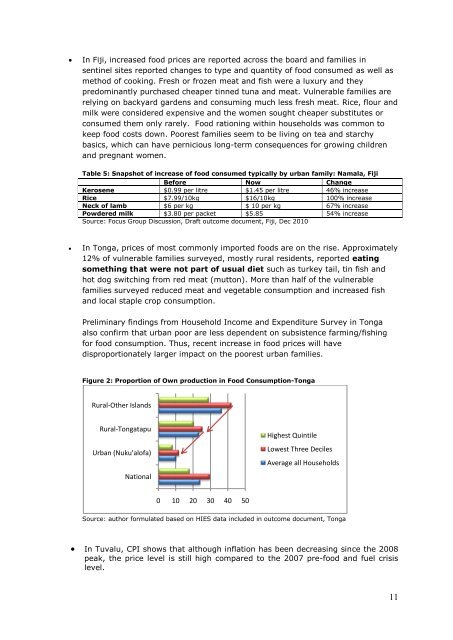Food Price Increases in the Pacific Islands - Unicef
Food Price Increases in the Pacific Islands - Unicef
Food Price Increases in the Pacific Islands - Unicef
Create successful ePaper yourself
Turn your PDF publications into a flip-book with our unique Google optimized e-Paper software.
In Fiji, <strong>in</strong>creased food prices are reported across <strong>the</strong> board and families <strong>in</strong><br />
sent<strong>in</strong>el sites reported changes to type and quantity of food consumed as well as<br />
method of cook<strong>in</strong>g. Fresh or frozen meat and fish were a luxury and <strong>the</strong>y<br />
predom<strong>in</strong>antly purchased cheaper t<strong>in</strong>ned tuna and meat. Vulnerable families are<br />
rely<strong>in</strong>g on backyard gardens and consum<strong>in</strong>g much less fresh meat. Rice, flour and<br />
milk were considered expensive and <strong>the</strong> women sought cheaper substitutes or<br />
consumed <strong>the</strong>m only rarely. <strong>Food</strong> ration<strong>in</strong>g with<strong>in</strong> households was common to<br />
keep food costs down. Poorest families seem to be liv<strong>in</strong>g on tea and starchy<br />
basics, which can have pernicious long-term consequences for grow<strong>in</strong>g children<br />
and pregnant women.<br />
Table 5: Snapshot of <strong>in</strong>crease of food consumed typically by urban family: Namala, Fiji<br />
Before Now Change<br />
Kerosene $0.99 per litre $1.45 per litre 46% <strong>in</strong>crease<br />
Rice $7.99/10kg $16/10kg 100% <strong>in</strong>crease<br />
Neck of lamb $6 per kg $ 10 per kg 67% <strong>in</strong>crease<br />
Powdered milk $3.80 per packet $5.85 54% <strong>in</strong>crease<br />
Source: Focus Group Discussion, Draft outcome document, Fiji, Dec 2010<br />
<br />
In Tonga, prices of most commonly imported foods are on <strong>the</strong> rise. Approximately<br />
12% of vulnerable families surveyed, mostly rural residents, reported eat<strong>in</strong>g<br />
someth<strong>in</strong>g that were not part of usual diet such as turkey tail, t<strong>in</strong> fish and<br />
hot dog switch<strong>in</strong>g from red meat (mutton). More than half of <strong>the</strong> vulnerable<br />
families surveyed reduced meat and vegetable consumption and <strong>in</strong>creased fish<br />
and local staple crop consumption.<br />
Prelim<strong>in</strong>ary f<strong>in</strong>d<strong>in</strong>gs from Household Income and Expenditure Survey <strong>in</strong> Tonga<br />
also confirm that urban poor are less dependent on subsistence farm<strong>in</strong>g/fish<strong>in</strong>g<br />
for food consumption. Thus, recent <strong>in</strong>crease <strong>in</strong> food prices will have<br />
disproportionately larger impact on <strong>the</strong> poorest urban families.<br />
Figure 2: Proportion of Own production <strong>in</strong> <strong>Food</strong> Consumption-Tonga<br />
Rural-O<strong>the</strong>r <strong>Islands</strong><br />
Rural-Tongatapu<br />
Urban (Nuku'alofa)<br />
National<br />
Highest Qu<strong>in</strong>tile<br />
Lowest Three Deciles<br />
Average all Households<br />
0 10 20 30 40 50<br />
Source: author formulated based on HIES data <strong>in</strong>cluded <strong>in</strong> outcome document, Tonga<br />
In Tuvalu, CPI shows that although <strong>in</strong>flation has been decreas<strong>in</strong>g s<strong>in</strong>ce <strong>the</strong> 2008<br />
peak, <strong>the</strong> price level is still high compared to <strong>the</strong> 2007 pre-food and fuel crisis<br />
level.<br />
11

















